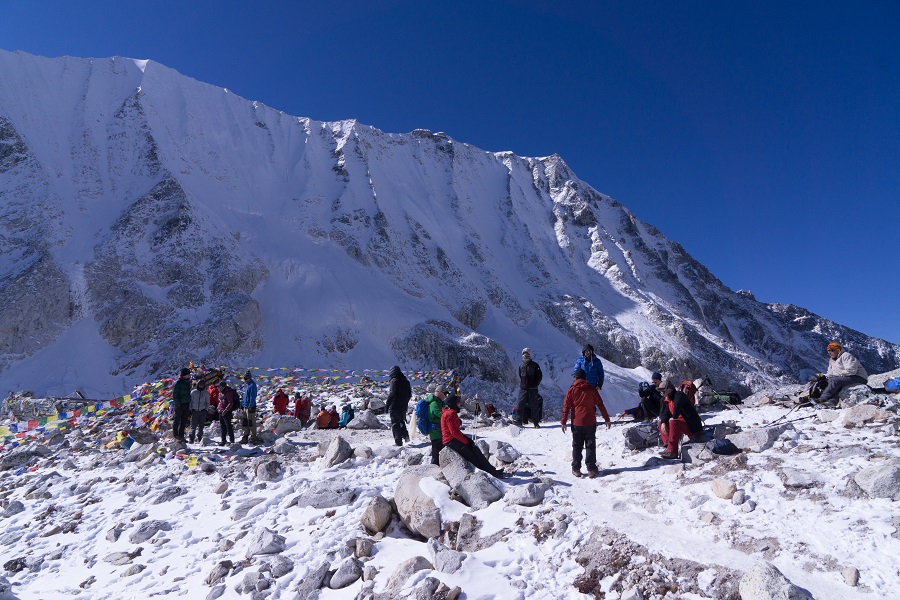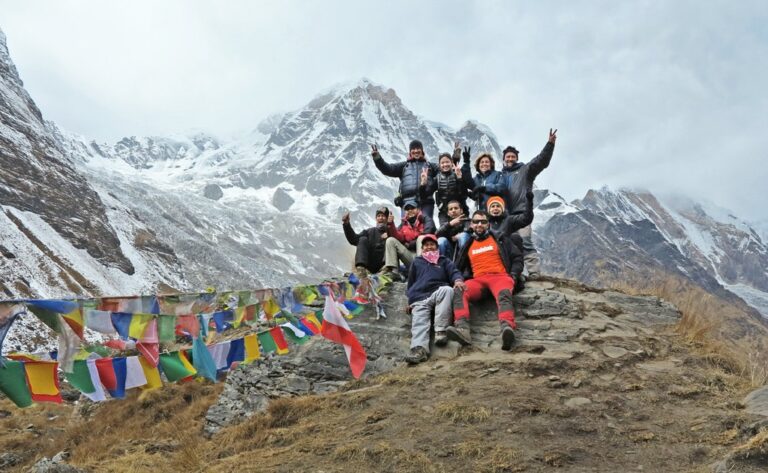The Manaslu Circuit Trek is an extraordinary adventure that immerses you in the stunning beauty of Nepal’s Himalayas.
Over the course of 13 days, you’ll journey through diverse landscapes, starting from the subtropical lowlands and ascending through lush forests, terraced fields, and traditional villages.
You’ll gradually encounter the breathtaking high-altitude scenery, culminating in the challenging crossing of Larke Pass at 5,160 meters (16,929 feet).
Unlike the more popular Annapurna and Everest circuits, the Manaslu Circuit offers a sense of solitude and authenticity.
As you trek, you’ll experience the rich Tibetan-influenced cultures and navigate varied terrains, from dense forests and glacial rivers to alpine meadows and rugged high-altitude paths.
This trek is physically demanding and requires good fitness and acclimatization to handle the altitude and trek duration. If you’re seeking a genuine Himalayan adventure away from the crowds, the Manaslu Circuit provides a unique blend of natural splendor and cultural immersion.
What kind of Food and accommodation is available in Manaslu Circuit Trek?
On the Manaslu Circuit Trek, accommodations and food options vary based on altitude and village development. Here’s a detailed overview of what you can expect.

Accommodation
Lodges and Guesthouses
Lower Elevations (Soti Khola to Jagat): In these lower-altitude villages, you’ll find basic lodges and guesthouses. These accommodations are usually simple, offering a bed with a blanket and shared bathroom facilities. The lodges may have a few amenities such as electricity for charging devices and basic heating.
Mid-Altitude (Deng to Namrung): As you move to mid-altitude villages, the lodges may become slightly more comfortable. They still offer basic facilities but may include more private rooms and slightly improved amenities. Hot showers might be available in some places, though they are often shared and may incur an additional fee.
High Altitude (Lho to Samdo): In higher-altitude areas, accommodations are more basic due to the remote location. Expect simple lodges with shared bathrooms and limited amenities. Rooms are generally shared with other trekkers, and facilities are more rudimentary.
Tea Houses and Monasteries
Sama Gaun and Bimthang: At higher altitudes, particularly in Sama Gaun and Bimthang, you’ll find tea houses and monasteries that offer basic lodgings. These provide a place to sleep, though comfort levels are modest. The rooms are typically small with minimal furnishings.
Dharmasala: This is a very basic stop, and accommodation here is quite minimal. There may be a few lodges or tea houses where you can rest, but expect very basic conditions.
Food
Local and Western Cuisine
Breakfast: Typical options include porridge, eggs (boiled, scrambled, or as an omelet), pancakes, and toast. Tea and coffee are generally available.
Lunch: Common lunch items include noodle soups, dal bhat (rice and lentil soup), momo (dumplings), and fried rice. Some lodges offer pasta and other Western dishes.
Dinner: Dinner menus usually feature a variety of dal bhat, vegetable curry, momo, noodles, and occasionally meat dishes. In higher altitudes, the variety of food may be limited due to the remote nature of the lodges.
Availability of Fresh Ingredients
Lower Elevations: In lower villages, you’ll have access to a broader variety of fresh produce and ingredients, allowing for more diverse meal options.
Higher Elevations: As you ascend, fresh produce becomes less available, and food is often made from preserved ingredients. Meals may become more basic and less varied.
Special Considerations
Dietary Restrictions: Most lodges can accommodate vegetarian and some special dietary needs with advance notice. However, options may be limited, especially at higher altitudes.
Hydration: It’s important to drink plenty of water. You can usually buy bottled water or treat tap water with purification tablets. Some lodges also provide hot drinks like tea and coffee.
How Difficult is Manaslu Circuit Trek ?
The Manaslu Circuit Trek is considered a challenging trek due to its diverse terrain, high altitude, and length. Here’s a breakdown of its difficulty:
Physical Demands
Length and Duration: The trek typically lasts 13 days, covering around 177 kilometers (110 miles). You’ll be trekking for about 6-8 hours each day, which requires a good level of physical fitness and stamina.
Altitude: The trek reaches an altitude of 5,160 meters (16,929 feet) at Larke Pass. High-altitude trekking comes with the risk of altitude sickness, so proper acclimatization is essential. You’ll need to manage your pace and allow time for acclimatization days.
Terrain: The terrain varies from gentle walks along riverbanks to steep, rocky ascents and descents. The trek includes river crossings, rough trails, and high-altitude paths, which can be physically demanding.
Weather Conditions
Unpredictability: Weather in the Himalayas can be unpredictable. The trek exposes you to cold temperatures, especially at higher altitudes. Snow and rain can impact the trails, making them slippery and challenging.
Seasons: The best times to trek are during the pre-monsoon (spring) and post-monsoon (autumn) seasons. Trekkers should avoid the monsoon period due to heavy rainfall and the winter season due to severe cold and snow.
Technical Skills
Navigation: While the trek is well-trodden, navigating through remote and rugged areas requires basic trekking and navigation skills. Some sections can be exposed, so caution is needed.
Altitude Experience: Prior experience with high-altitude trekking can be beneficial. The ascent to Larke Pass involves strenuous effort and can be taxing due to the altitude.
Day 1: Drive from Kathmandu to Soti Khola
You will start your adventure with a scenic drive from Kathmandu to Soti Khola, a distance of approximately 80 kilometers (50 miles). This journey takes around 8-9 hours, winding through lush landscapes, terraced fields, and small villages along the Trishuli River. The drive offers picturesque views of the Nepalese countryside, transitioning from urban to rural scenery. Upon arrival at Soti Khola, located at an elevation of 700 meters (2,296 feet), you’ll check into a local lodge or guesthouse and prepare for the trek ahead.
Day 2: Trek from Soti Khola to Machha Khola
The trek from Soti Khola to Machha Khola covers about 22 kilometers (13.7 miles) and takes approximately 6-7 hours. The trail follows the Budhi Gandaki River, passing through dense forests and terraced fields. You’ll cross several suspension bridges and traverse a variety of terrain, including gentle climbs and descents. Machha Khola, situated at an altitude of 930 meters (3,051 feet), is a small village where you’ll spend the night in a basic lodge, enjoying the tranquil river views.
Day 3: Trek from Machha Khola to Jagat
Today’s trek extends approximately 21 kilometers (13 miles) and requires around 5-6 hours. The route continues along the Budhi Gandaki River, with a mix of terrain including forests, terraced fields, and riverbanks. You’ll pass through several small villages, gaining insight into local life. Jagat, located at 1,340 meters (4,396 feet), is a larger village with more developed amenities. After arriving, you’ll rest in a comfortable lodge and prepare for the next leg of the journey.
Day 4: Trek from Jagat to Deng
On this day, you’ll cover about 22 kilometers (13.7 miles) in approximately 6-7 hours. The trail ascends through lush forests and terraced fields, crossing traditional Tibetan-influenced villages. Deng, situated at 1,804 meters (5,918 feet), is a small village offering basic accommodation. The trek involves navigating varied terrain, including river crossings and steady ascents. Once in Deng, you’ll settle into your lodge for a restful night.
Day 5: Trek from Deng to Namrung
Today’s trek spans approximately 20 kilometers (12.4 miles) and takes around 5-6 hours. The route continues to ascend through forests and terraced fields, passing through Tibetan-style villages. As you reach Namrung, situated at 2,630 meters (8,628 feet), you’ll experience a change in local culture and architecture. Namrung provides more developed lodgings and a chance to explore local traditions. Spend the evening resting and preparing for the higher altitudes ahead.
Day 6: Trek from Namrung to Lho
The trek from Namrung to Lho covers about 10 kilometers (6.2 miles) and takes approximately 3-4 hours. The trail offers stunning views of the Manaslu range as you ascend through alpine meadows and traditional villages. Lho, located at 2,957 meters (9,701 feet), is a charming village with a rich cultural heritage. The shorter trek allows for a relaxed pace and ample time to acclimatize and explore the local area.
Day 7: Trek from Lho to Sama Gaun
Today’s trek spans roughly 15 kilometers (9.3 miles) and takes around 4-5 hours. The route continues to offer impressive views of the Manaslu massif as you traverse through alpine meadows and past traditional villages. Sama Gaun, located at 3,530 meters (11,581 feet), is a picturesque village ideal for acclimatization. Spend the night in Sama Gaun, exploring the village and preparing for higher altitudes.
Day 8: Acclimatization Day (Day Trip to Manaslu Base Camp or Pungyen Gompa)
On this acclimatization day, you’ll have the option to take a day trip to Manaslu Base Camp (about 8-9 hours round trip) or Pungyen Gompa (6-7 hours round trip). The trek to Manaslu Base Camp covers approximately 16 kilometers (10 miles) round trip, reaching an altitude of 4,400 meters (14,435 feet). Alternatively, a trip to Pungyen Gompa involves a 14-kilometer (8.7 miles) round trip. Both options offer stunning views and help with acclimatization.
Day 9: Trek from Sama Gaun to Samdo
The trek from Sama Gaun to Samdo covers about 14 kilometers (8.7 miles) and takes approximately 3-4 hours. As you ascend through high-altitude terrain, you’ll be rewarded with views of the surrounding peaks and valleys. Samdo, situated at 3,865 meters (12,680 feet), is a small, remote village known for its Tibetan influences. The shorter trek allows for further acclimatization and exploration of the local area.
Day 10: Acclimatization Day (Day Trip to Tibet Border)
On this acclimatization day, you’ll take a day trip towards the Tibet border, with a round trip covering approximately 16-18 kilometers (10-11 miles) and taking around 6-8 hours. The hike provides spectacular high-altitude views and a unique perspective on the remote landscape. The additional altitude gain helps with acclimatization for the upcoming trek over Larke Pass. Return to Samdo for the night.
Day 11: Trek from Samdo to Dharmasala
Today’s trek covers approximately 16 kilometers (10 miles) and takes around 4-5 hours. The route ascends through rugged high-altitude terrain, offering views of the Larke Glacier and surrounding peaks. Dharmasala, located at 4,460 meters (14,632 feet), is a small settlement serving as a crucial resting point before crossing Larke Pass. Spend the night in Dharmasala, preparing for the challenging ascent to the pass.
Day 12: Trek from Dharmasala to Bimthang via Larke Pass
The trek from Dharmasala to Bimthang is a challenging 22-kilometer (13.7 miles) journey that takes around 8-10 hours. You’ll start early to cross Larke Pass at 5,160 meters (16,929 feet), the highest point of the trek. The climb is demanding but rewards you with breathtaking panoramic views of the Himalayas. After crossing the pass, you’ll descend to Bimthang, located at 3,590 meters (11,778 feet), where you’ll spend the night in a comfortable lodge.
Day 13: Trek from Bimthang to Dharapani
The final trek covers approximately 20 kilometers (12.4 miles) and takes around 6-7 hours. The route descends through lush forests and traditional villages, transitioning from high-altitude landscapes to more temperate conditions. Upon reaching Dharapani, you’ll be able to arrange transportation back to Kathmandu. Dharapani serves as a convenient endpoint for your trek, offering a chance to reflect on your journey and prepare for your return.

